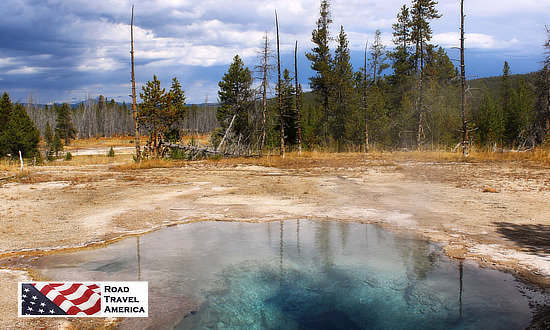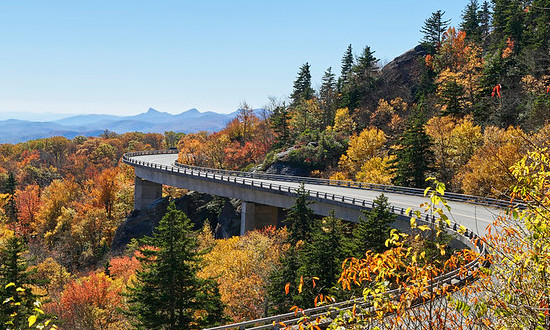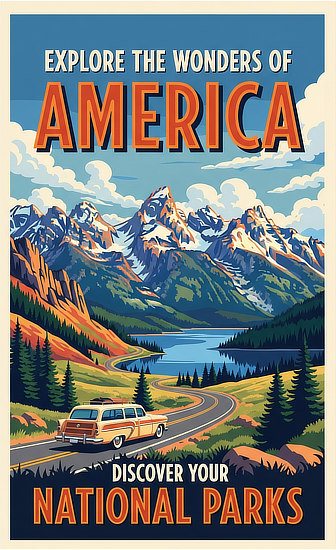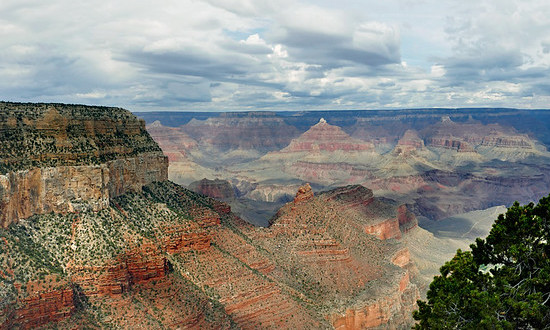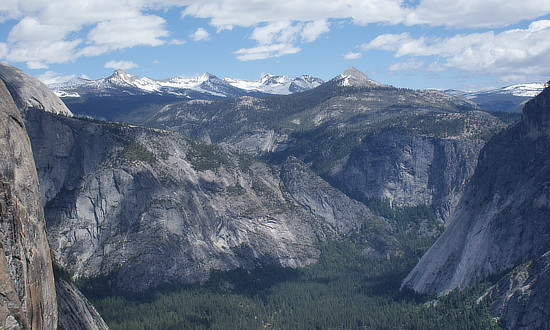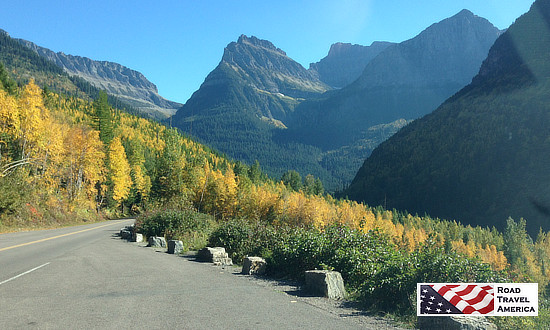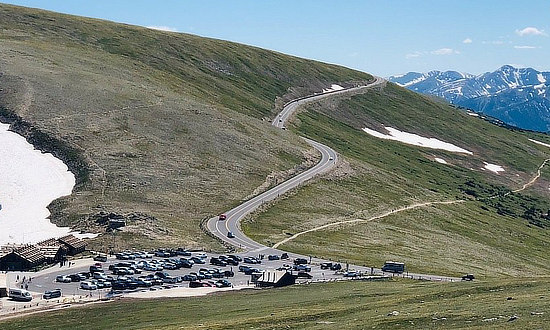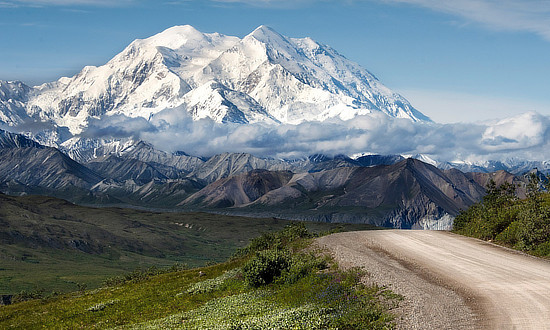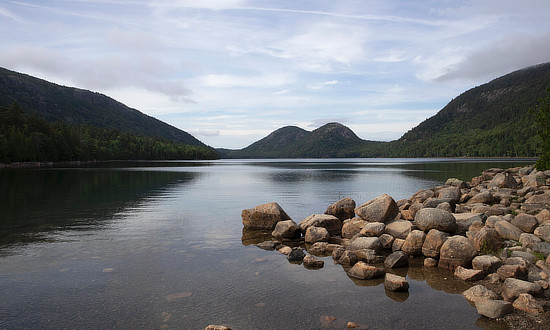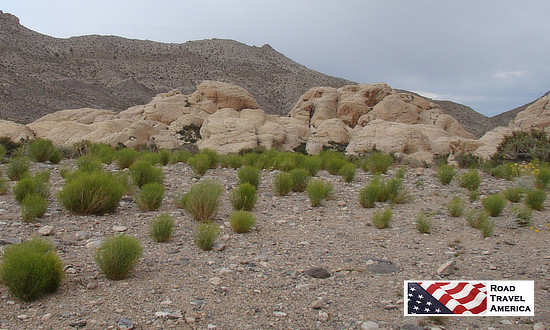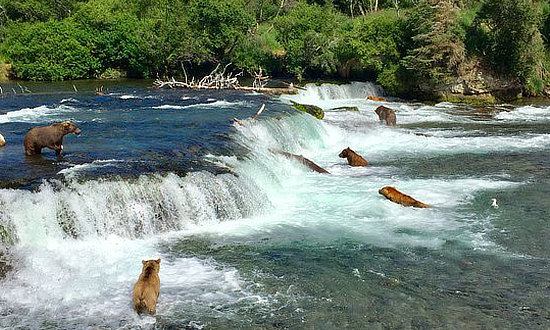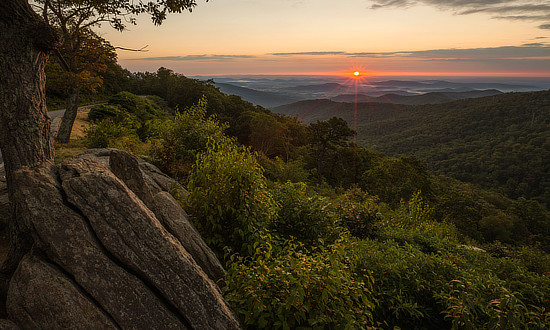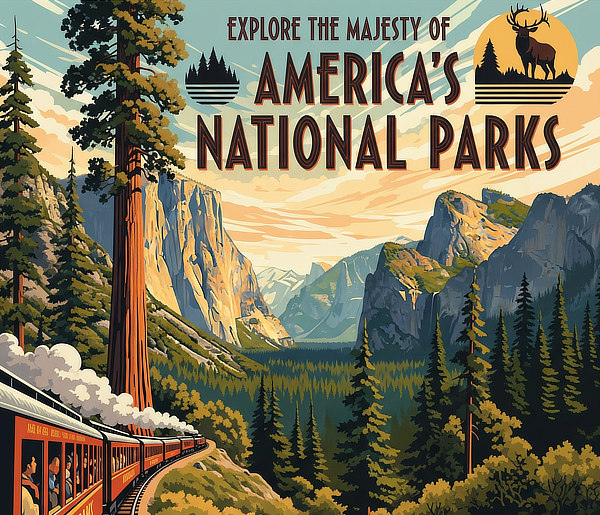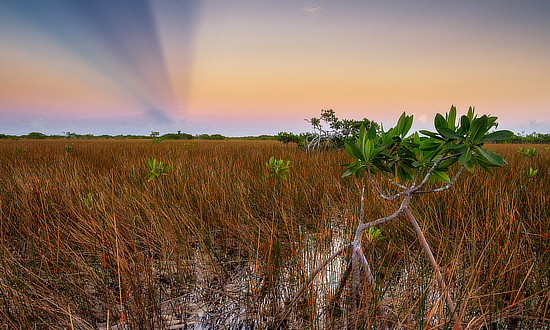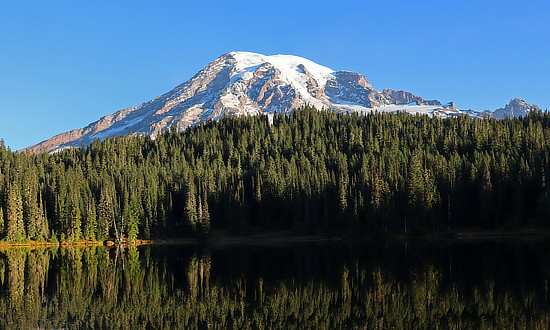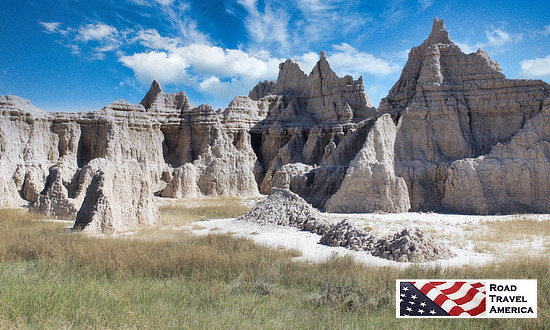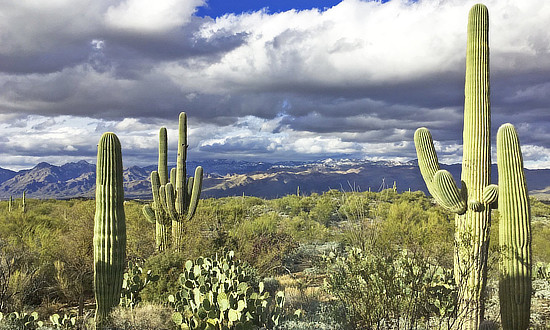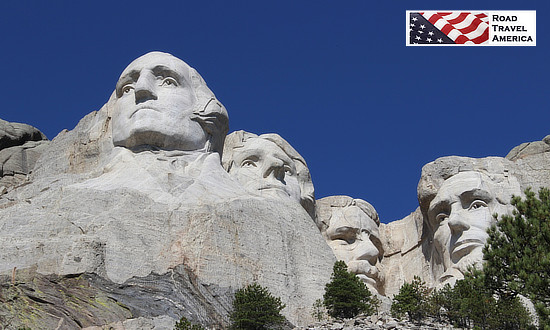
Travel to the National Parks of America in 2025
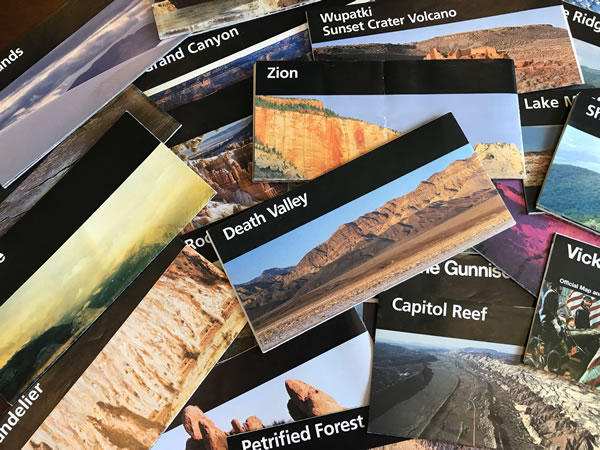 The U.S. offers a variety of outdoor National Park spaces! |
The United States has the good fortune of having an excellent national parks system, dating back over a hundred years. The National Park Service (NPS), with the help of volunteers and park partners, protects nearly 400 places for 331 million visitors every year.
Our National Parks Service does an outstanding job of administering the parks, and preserving our natural and historical heritage, especially considering the funding limitations paced on them by Congress.
Included on this website are venues designated as "national parks," plus national monuments, historical sites and other parks. Also featured are some Canadian parks such as Banff National Park.
We have included an assortment of photographs, maps, commentary, lodging suggestions, and reviews to help you plan your 2025 trip to a national park.
Yellowstone National ParkYellowstone National Park features more than 10,000 hydrothermal features and 500 geysers. Old Faithful geyser erupts about every 74 minutes. One of the other main attractions in the park is its wildlife, including bears, fox, elk, bison, lynx, 285 species of birds and more. Yellowstone Lake covers over 131 square miles of area, reaching a maximum depth of 138 feet. Visitors to the park marvel at a supervolcano's hidden power under the earth, rising up in colorful hot springs, mudpots, and geysers. The park has thousands of acres of mountains, forests, rivers, and lakes, and endless species of wildlife to watch. Hiking, camping, fishing, photography, bicycling, boating, horseback riding, snowmobiling, snowcoach tours, and ranger programs are available. Read more about Yellowstone National Park |
|
Great Smoky Mountains National Park in North Carolina and TennesseeThe Park spans over 800 square miles in Tennessee and North Carolina, and is one of the most pristine natural areas in the Eastern part of the United States. It offers visitors and endless variety of outdoor activities such as camping, hiking, climbing, bicycling, fishing, horse riding, historical sights, picnicking and involvement in ranger-led programs. Read more about Great Smoky Mountains National Park |
|
|
|
Grand Canyon National Park in ArizonaGrand Canyon National Park is located in Arizona, centered on a Colorado River canyon 277 river miles long, up to 18 miles wide, and a mile deep. The Park is one of the world's most popular natural attractions, with attendance exceeding 6 million visitors a year. Popular activities include rafting, hiking, skydiving, nature studies, geology exploration, jeep tours and helicopter rides. The floor of the valley is accessible by foot, muleback, or by boat or raft from upriver. Read more about Grand Canyon National Park |
|
Yosemite National Park in CaliforniaLocated in central California, Yosemite National Park's most famous sight is the granite monolith of Half Dome, a mountain whose sheer face and rounded top looks like a giant stone dome split in half. The Valley is a 7-mile wide canyon with incredible rock formations, including El Capitan, the world's tallest granite monolith and one of the world's top rock climbing destinations. Equally famous for its waterfalls, Yosemite Falls is one of the highest waterfalls in the world. Read more about Yosemite National Park in California |
|
Glacier National Park in MontanaGlacier National Park covers 1,012,837 square miles and includes 131 named lakes. St. Mary Lake is located in the eastern side of the park, while Lake McDonald lies to the west. Lake McDonald is the largest lake, 9.4 miles long; 1.5 miles wide and 464 feet deep. Elevation at Logan Pass is 6,646 feet, while the highest mountain, Mt. Cleveland, rises to a height of 10,448 ft. The park includes 25 named glaciers, and is traversed by the Going to the Sun Road. Read more about Glacier National Park |
|
Rocky Mountain National Park in ColoradoRocky Mountain National Park in Coloradospans 415 square miles of spectacular mountain environments. A highlight of the park is Trail Ridge Road which crests at over 12,000 feet. The park features over 300 miles of hiking trails, lakes and a variety of wildlife. RMNP is located adjacent to Estes Park, and about 70 miles northwest of Denver. The Continental Divide runs northwest to southeast through the center of the park atop the high peaks. Read more about Rocky Mountain National Park |
|
Denali National Park & Preserve in AlaskaDenali National Park and Preserve is located in the interior area of the State of Alaska. It was previously known as as Mount McKinley National Park. The park is centered on Denali, the highest mountain in North America, with a summit elevation of 20,310 feet (6,190 m) above sea level. Denali is the third most prominent and third most isolated peak on Earth, after Mount Everest and Aconcagua. Glaciers cover one million acres of Denali -- that's one-sixth of the park. Read more about Denali National Park & Preserve |
|
Acadia National Park in MaineAdjacent to popular Bar Harbor, Acadia National Park features 50 square miles of mountains, lakes, hiking, biking, views and dramatic coastline vistas. The park is open for activity year-round. In the winter the carriage roads are converted into trails for cross-country skiing and snowshoeing, and the Park Loop Road turns into a paradise for snowmobile use and fat-tire biking. Read more about Acadia National Park |
|
Zion National Park in UtahTowering red cliffs and outdoor activities make Zion National Park a popular vacation destination in southwestern Utah. A prominent feature of the park of 229 square miles is Zion Canyon, 15 miles long and about half a mile in depth. Outdoor activities are popular, including hiking, climbing, bicycling, river trips and exploring the Narrows. Access to the main section of the park is via two points along State Route 9, the east entrance and the south entrance at Springdale. The Kolob Canyons entrance is on Interstate 15. Read more about Zion National Park in Utah |
|
Death Valley National Park in CaliforniaDeath Valley is the largest U.S. National Park outside Alaska, spanning 3.4 million acres. The park includes low valley floors crusted with barren salt flats, rugged mountains rising as much as 11,000 feet, deep and winding canyons, rolling sand dunes, and spring-fed oases. Badwater Basin, at 282 feet below sea level, is not only the lowest place in the park, it's the lowest in North America. Read more about Death Valley National Park |
|
Katmai National Park & Preserve in AlaskaKatmai National Park is located 260 miles southwest of Anchorage, Alaska, and is a true wilderness destination. It is notable for its volcanoes, lakes, Brooks Riverand its falls, the Valley of Ten Thousand Smokes and for its large population of brown bears. The park is located on the Alaska Peninsula, across from Kodiak Island, with headquarters in nearby King Salmon. Read more about Katmai National Park & Preserve |
|
Arches National Park in UtahArches National Park in eastern Utah near the city of Moab has over 2,000 natural stone arches, in addition to hundreds of soaring pinnacles, massive fins and giant balanced rocks. The park features the densest concentration of natural stone arches in the world, including the popular "Delicate Arch". A paved scenic drive takes visitors to many of the major viewpoints within the park. Hikers can choose from a wide variety of trails, from short twenty minute walks to more adventurous hikes into lesser seen areas. Read more about Arches National Park |
|
Shenandoah National ParkShenandoah National Park, in the Blue Ridge Mountains in the State of Virginia, is linear in nature, mostly in a north to south orientation. On the west side of the park is the Shenandoah River and Shenandoah Valley. The Virginia Piedmont lies to the east of the park. A premier destination in the park is Skyline Drive, running 105 miles along a dominant ridge in the mountains. The two-lane road begins in the north at Front Royal, and ends at the starting point of the Blue Ridge Parkway. Read more about Shenandoah National Park |
|
|
|
Bryce Canyon National Park in UtahBryce Canyon National Park is located in the southwestern section of Utah, south of Utah Scenic Byway 12. The park features the largest collection of hoodoos, odd-shaped pillars of rock left standing from the forces of erosion, in the world. It offers four main viewpoints: Bryce Point, Inspiration Point, Sunset Point, and Sunrise Point. Other viewpoints are found all along the park's 18-mile main road. Read more about Bryce Canyon National Park |
|
Everglades National Park in FloridaThe Everglades is an expansive area of land in extreme southern Florida, southwest of Miami, and southeast of Naples. The ecosystem of the Everglades is not presently found anywhere else on earth. Everglades National Park is the third largest park in the lower 48 states, covering 2,400 square miles! The system begins near Orlando with the Kissimmee River, which discharges into the vast, shallow Lake Okeechobee. Read more about Everglades National Park |
|
Mount Rainier National Park in WashingtonMount Rainier National Park is ocated about 85 miles southeast of Seattle; magnificent vistas and lakes, camping and hiking. This stratovolcano reaches a summit peak of 14,411 feet above sea level, and is the highest mountain in Washington and the Cascade Range. Most visitors to Mt. Rainier choose to stay in the largest nearby city, Yakima, which offers a variety of hotels and other lodging. Lodging in the park includes the National Park Inn and Paradise Inn. Camping and wilderness camps are also available. Read more about Mount Rainier National Park |
|
Badlands National Park in South DakotaThe Badlands National Park, in southwestern South Dakota near Rapid City and Mount Rushmore Memorial Park, features sharply eroded buttes, pinnacles and spires surrounded by a mixed-grass prairie ecosystem. The park has spectacular landscapes, native mixed grass prairie, a large variety of native wildlife, amazing fossils, wonderful skyscapes, and compelling human history. Read more about Badlands National Park |
|
Saguaro National Park in ArizonaSaguaro National Park protects some of the most impressive forests of these sub-tropical giants, on the edge of the modern City of Tucson. The park is located in two different sections: Tucson Mountain District (west), and the Rincon Mountain District (east). Tucson is situated on an alluvial plain in the Sonoran desert, surrounded by five ranges of mountains: the Santa Catalina Mountains and the Tortolita Mountains, the Santa Rita Mountains, the Rincon Mountains, and the Tucson Mountains. Read more about Saguaro National Park |
|
Mount Rushmore National Memorial in South DakotaLocated in the southwestern corner of South Dakota is the iconic Mount Rushmore National Memorial, featuring massive 60-foot (18-m) sculptures of four former United States presidents. While not a national park, it has large numbers of visitors and is well known nationwide. We highly recommend including a visit to nearby Custer State Park, with its granite peaks and rolling plains. The park is home to abundant wildlife, including bison, wild burros, mountain goats and many other animals. Also located nearby is the Crazy Horse Memorial. Read more about Mount Rushmore National Memorial |
|
Monument Valley Navajo Tribal Park in UtahMonument Valley Navajo Tribal Park is located in extreme southeastern Utah, on the northern border of Arizona. It is operated by the Navajo Nation, not the National Park Service. The valley is host to towering sandstone rock formations that have been sculpted over time and soar 400 to 1,000 feet above the valley floor. Over the years, Monument Valley has been the locale for the filming of numerous movies starring such film legends as John Wayne. Read more about Monument Valley Navajo Tribal Park |
List of All National Parks in the United States
We've visited many of the following national parks, and are working on posting reviews of these facilities ...
| State or Territory | National Park |
| Alaska | Denali National Park and Preserve |
| Alaska | Gates of the Artic National Park and Preserve |
| Alaska | Glacier Bay National Park and Preserve |
| Alaska | Katmai National Park and Preserve |
| Alaska | Kenai Fjords National Park |
| Alaska | Kobuk Valley National Park |
| Alaska | Lake Clark National Park and Preserve |
| Alaska | Wrangell-St. Elias National Park and Preserve |
| American Samoa | American Samoa National Park |
| Arizona | Grand Canyon National Park |
| Arizona | Petrified Forest National Park |
| Arizona | Saguaro National Park |
| Arkansas | Hot Springs National Park |
| California | Channel Islands National Park |
| California | Death Valley National Park |
| California | Joshua Tree National Park |
| California | Kings Canyon National Park |
| California | Lassen Volcanic National Park |
| California | Pinnacles National Park |
| California | Redwood National Park |
| California | Sequoia National Park |
| California | Yosemite National Park |
| Colorado | Black Canyon of the Gunnison National Park |
| Colorado | Great Sand Dunes National Park |
| Colorado | Mesa Verde National Park |
| Colorado | Rocky Mountain National Park |
| Florida | Biscayne National Park |
| Florida | Dry Tortugas National Park |
| Florida | Everglades National Park |
| Hawaii | Haleakala National Park |
| Hawaii | Hawaii Volcanoes National Park |
| Indiana | Indiana Dunes National Park |
| Kentucky | Mammoth Cave National Park |
| Maine | Acadia National Park |
| Michigan | Isle Royale National Park |
| Minnesota | Voyageurs National Park |
| Missouri | Gateway Arch National Park |
| Montana | Glacier National Park |
| Nevada | Great Basin National Park |
| New Mexico | Carlsbad Caverns National Park |
| New Mexico | White Sands National Park |
| North Carolina & Tennessee | Great Smoky Mountains National Park |
| North Dakota | Theodore Roosevelt National Park |
| Ohio | Cuyahoga Valley National Park |
| Oregon | Crater Lake National Park |
| South Carolina | Congaree National Park |
| South Dakota | Badlands National Park |
| South Dakota | Mount Rushmore National Memorial |
| South Dakota | Wind Cave National Park |
| Texas | Big Bend National Park |
| Texas | Guadalupe Mountains National Park |
| Utah | Arches National Park |
| Utah | Bryce Canyon National Park |
| Utah | Canyonlands National Park |
| Utah | Capitol Reef National Park |
| Utah | Zion National Park in Utah |
| Virginia | Shenandoah National Park |
| Virgin Islands | Virgin Islands National Park |
| Washington | Mount Rainier National Park |
| Washington | North Cascades National Park |
| Washington | Olympic National Park |
| West Virginia | New River Gorge National Park & Preserve |
| Wyoming | Grand Teton National Park |
| Wyoming, Montana & Idaho | Yellowstone National Park |
More Travel Tips & Inspirations ... from TripAdvisor
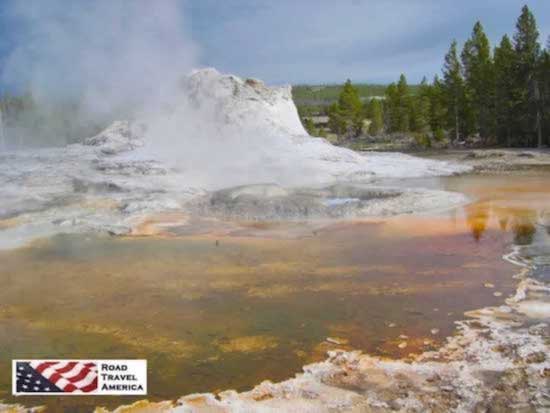 An active geyser at Yellowstone National Park |
